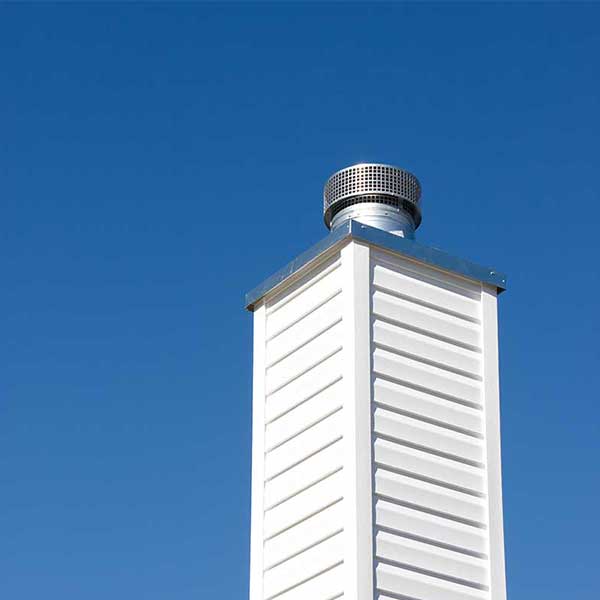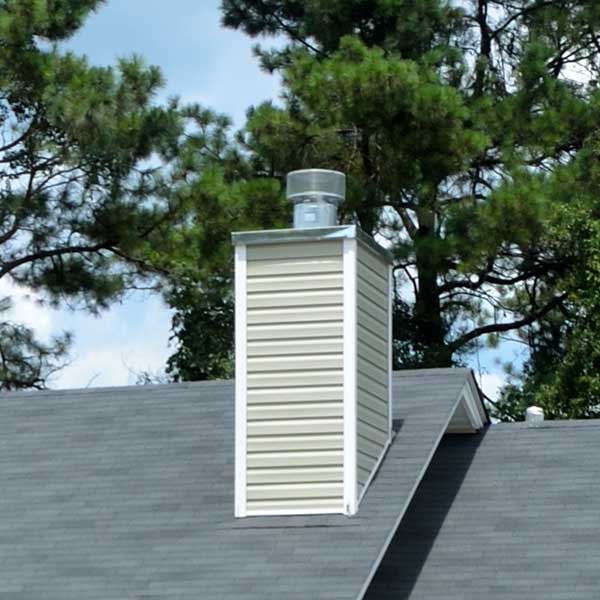We Can Help You Find the Right Chase Cover for Your Prefabricated Chimney
When you think of a fireplace and chimney, a masonry chimney system probably springs to mind. It is the classic chimney setup, and one that has been around for centuries. Beginning in the 1960s, though, homeowners saw a reimagining of residential chimneys in prefab systems.
Prefabricated – or prefab – chimney systems are built offsite in a factory, transported to the residence later, and installed during construction. Prefab chimney systems are typically stainless steel, and they make a great addition for those looking to install a fireplace without having to build one brick by brick on site.
Ozark Stove & Chimney services masonry chimneys, prefab chimneys, and factory-built chimneys for residents living in the Greene County, MO and Benton County, AR area. Give us a call with questions or to book your next service with us.
What Is a Chimney Chase Cover?
So, before we get into the types of chase covers and which model would be best suited to your home, let’s get the first big question out of the way… What exactly is a chase cover? Is it like a chimney cap? Does it take the place of a chimney crown? What’s its actual purpose?
Let’s start with the chase – the part the chase cover, well… covers. A chimney chase is the long, narrow structure that houses the venting materials for a factory-built or prefab heating appliance. It essentially surrounds and protects that pipe, so that it doesn’t face damage and corrosion from outside elements – and so that it looks nicer too. They may be made of brick, wood, vinyl, or metal siding.
Chase covers are typically found on chases connected to factory-built or prefab fireplaces – although sometimes we see them on masonry setups – and cover the opening at the top of the chase. Similar to a chimney crown on a masonry chimney, they divert water away from the chimney and off of the roof.

Types of Covers on a Chimney Chase
One thing you’ll have to decide before having your new chase cover installed is what type of cover you want. Now, this leaves some confused as to what types of chase covers are available… isn’t it just a standard one-size-fits-all part for any prefab system out there?
Not exactly. In fact, chimney chase covers are available in a wide variety of materials, the four most common being aluminum, stainless steel, galvanized steel, and copper, each with their own list of pros and cons. Which is right for you?
Aluminum
The two big upsides in going with an aluminum chimney chase cover are that it is 1) on the more affordable end of the chase cover spectrum and 2) it isn’t prone to rust like other options.
Unfortunately, aluminum is also a softer metal – meaning it is lightweight and may be more prone to damage on days with high winds or flying debris. So, what you save on initial costs might come back to bite you if you experience damage later on.
Stainless Steel
Who wins the popularity contest for most popular chase cover material? Stainless steel, hands down. It’s known for being low-maintenance and should hold up for the long haul with regular inspections and cleanings. Stainless steel is a harder metal and very durable. It is also water-resistant and is not prone to rusting.
The one downside? It tends to be a slightly pricier investment. That said, this usually evens out when you consider it won’t need replacing anytime soon, as it has a lifetime warranty.
Galvanized Steel
Galvanized steel is the most affordable metal used on chimney chase covers. However, it tends to rust easily, so you will need to replace it within a few years. If you’re looking for a cheap, short-term solution, this is just fine… just don’t plan on it lasting for the long haul.
Copper
Copper is a high-quality metal known for its durability. It can endure turbulent weather conditions and is resistant to rust. Copper is also known for its aesthetic appeal and may be of special interest to homeowners with an eye towards design. That said, like stainless steel, plan on paying more for this premium material if this is the route for you.
Why Do I Need a Chimney Chase Cover?
Chimney chase covers are critical to the performance of your chimney system for several reasons. Their overall function is like a combination of a chimney cap and a chimney crown. Count on your chase cover for offering the following:
- Protection Against the Elements: A properly installed chimney chase cover will act as a protectant for the exposed top of the chimney. It keeps the chimney dry by keeping out water, snow, ice, and other elements, and it stops water from entering the chase, ensuring it doesn’t cause damage to the system and its components.
- Wildlife Prevention: Can you blame tiny critters, like birds and squirrels, for being attracted to your warm and sturdy chimney? We can’t. Unfortunately, this presents safety issues because they can clog your flue and invite fire hazards, as well as damage the construction components. And while they’re usually able to be extracted, in some cases, animals cannot be removed or relocated due to federal restrictions. The best way to avoid that type of inconvenience is to make sure you have a properly installed chimney chase cover, as well as a chimney flue cap.
- Protection Against Sparks: Sparks and embers are a natural part of burning a fire in a fireplace. Unfortunately, they can escape through the chimney during normal ventilation – and if an ember lands on your roof, it can lead to a fire. A metal chimney chase cover in combination with a chimney cap can stop sparks from landing on your combustible chimney top, roof, and any nearby vegetation, reducing the chances of a fire.
- Structural Stability: A chimney chase cover protects the chimney chase and helps reinforce the structural integrity of the entire chimney system. If debris, rain, and critters gain easy access, you’d be surprised at how quickly things can start breaking down… and usually a homeowner won’t even notice until it’s too late and damages have become costly to address.
- Improved Energy Efficiency: An uncovered chimney chase can allow drafts of air to enter your home through the chimney. This can lead to a loss of heat during colder months, thereby bumping up energy consumption. A tightly secured chase cover that’s properly installed can minimize these drafts, stove water entry, and save you a lot of money in heating costs.
Ready to get yours installed? Reach out online or call on our techs today.
How Long Does Chimney Chase Cover Last?
Like most things in life, chase covers don’t last forever – unless they are highly durable stainless steel and copper options – so you should expect to replace it at some point. What point will that be? Well, we can’t predict the exact lifespan you can expect from your chase cover, as durability and longevity are impacted by the materials used, whether or not it is installed correctly, and its exposure to environmental conditions. We’d be happy to go over it all with you, though, if you give us a call!
Have you experienced damage?
If your chimney chase cover is damaged or has endured considerable wear and tear, then it needs to be repaired or replaced as soon as possible. The most common cause of damage comes from corrosion and rust, which can lead to leaks and holes in your chase cover. Once rust begins, it only gets worse.

The easiest way to keep track of the status of your chimney chase is to schedule annual chimney inspections with Ozark Stove & Chimney. Our technicians are certified through the Chimney Safety Institute of America (CSIA) and will perform a complete assessment of your chimney system, including the chase and chase cover. We are trained to spot signs of damage and will tell whether your chimney chase cover needs to be repaired or replaced.
What Causes Chimney Chase Cover Damage?
Most of the time, if you invest in regular maintenance from professionals like us, as well as operate your fireplace properly, your chase covers can last several years. That said, they’re also one of the most exposed parts of your chimney, so they’re definitely not immune to damage – and it’s best to be prepared for anything.
So, what’s most likely to put an end to your chase cover?
Rust and Corrosion
As noted above, chimney chase covers are constantly exposed to weather conditions. On sunny days, this isn’t such a big deal, but when winds, rains, and snowfall arrive, watch out…
The more these units have to stand up against rain, snow, hail, and intense winds, the more likely they are to experience corrosion, dents, and rust. And if the chimney chase cover is of lower-quality materials and is not prepared with a preservative coating, it is at an increased chance of deterioration. Corrosion will weaken the cover over time, making it susceptible to cracks and leaks which will result in water damage.
Faulty Installation
A chimney chase cover must be fitted to the chase correctly. If it is not installed properly, water can seep into gaps and crevices and directly into the chase. If the cover is loose, it can fall off completely in certain weather conditions, exposing your chimney system to water damage, which will then lead to structural issues. Having a chimney professional complete the installation is the best way to make sure your chimney chase cover is secure.
Creepy Critters
Animals love chimneys. Whether it’s birds or roof rats, wildlife will seek out shelter in chimneys because they are quiet and somewhat isolated. Rodents and birds like to build nests from materials like insulation and twigs, which present fire hazards. If the critters are very active, they can even scratch or dent the chase cover, leading to damage in the long term.
Weather Conditions
Chimney chase covers are exposed to the elements of nature – there’s no way around this. Normal rain and snow patterns can lead to rust over long periods of time, and sudden changes in the weather can raise those stakes. Heavy rainfall, hail, and intense winds can damage nearby trees and property, and if some of that debris falls onto your chimney, it can cause dents or cracks on the chimney chase cover. When that type of damage is overlooked and not attended to promptly, water damage is inevitable.
Can I Install a Chimney Chase Cover Myself?
You’ve watched a bunch of DIY tutorials, you’ve been binging HGTV, and you’ve successfully completed a bunch of home projects all on your own. So, you’ve got this, right?
Hold on just a second. Although some homeowners have the necessary skills and tools to take on important home improvement projects on their own, chimney work is dangerous and can be intricate. You are putting yourself, your chimney, and your home at risk if the process isn’t addressed properly or with the correct safety equipment. Our CSIA-certified chimney professionals are well-versed in the latest industry guidelines and have extensive experience in working on roofs.
If your primary concern is cost, we completely understand. However, if you try to install a chimney chase cover yourself, you run the risk of doing it incorrectly, which will then lead to water damage. Unchecked water leaks will then lead to more damage, requiring the skill of a professional to repair properly. Meaning, whatever money you save in the short term by trying to do an install yourself will not be as much as you have to spend to correct issues like brick spalling or cracked mortar down the line.
There is no shame in making mistakes or learning as you go, but a chimney chase cover install is a big project. If the cover is not secure or tightly fitted, you are exposing your chimney to water and debris – and your household to increased risks. Play it safer and smarter by working with us from the start.
How Much Does a Chimney Chase Cover Cost?
The cost of a chimney chase cover, along with the installation, can vary, so we don’t have a solid answer for you. Some materials are cheaper than others (copper is more expensive than galvanized steel) and the scope of work can vary depending on the setup of your chimney system. The cost between a chase cover repair and a complete replacement will also impact any estimates.
To determine how much your project may cost, here’s what we suggest… reach out to the Ozark Stove & Chimney team. We’ll discuss different options, talk about your personal preferences and needs, then schedule an inspection to get a full assessment of your chimney’s setup.
Once we’re through with that, we’ll get you a more accurate estimate, so you can move forward with the best information available.
Ready to Schedule Your Next Service?
Are you concerned about the state of your chimney chase cover or believe it may be damaged? Call our customer support team at Ozark Stove & Chimney and we will send out one of our CSIA-certified technicians to do a comprehensive inspection of your chimney. You can schedule an appointment on our website or call us at 417-201-6585.
We serve Green County, Christian County, Stone County, Dallas County, Benton County, Marion County, and more. If you are not sure if you fall within our service area, please reach out to us. We’d love to hear from you!
Having us inspect your chimney flashing could help us determine the source of your chimney leak so we can repair it.
